Trip Report – 20-28 January 2012: Taranaki Summer Camp
Day 1, 20/1/12: Gordon Park Scenic Reserve
En route to Taranaki, we were led by the Whanganui Museum Botanical Group through this reserve, a swamp forest remnant, near Whanganui. At the carpark we were intrigued with the divaricate plants nearby such as
Melicope simplex and
Melicytus micranthus on the tawa-titoki bush edge. Emergent kahikatea were small, indicating logging activities last century. While having lunch, we were told the history of the reserve, from its preservation in the 1850s as part of a farmed area, and its reservation in the 1920s by the city council, with help from bequests. While noting many shrubs and lianes on the plant list, we went to sites rich in dicotyledonous herbs among the damp, partly-shaded interior. One site had an area of
Gratiola concinna, a herb unfamiliar to us. Then we saw patches of
Mazus novaezeelandiae,
Cardamine sp.,
Callitriche muelleri and
Stellaria parviflora – good training in identifying herb species!
The current status of the reserve is a credit to the group advocating for its care. Locally sourced plantings in gaps and around the edges are backed up by extensive hand-weeding at regular intervals. Spraying of some weeds is managed by DOC, although the care group would like to see it receive more intensive care.
Waverley Beach
After an introduction to landforms and local wahi tapu at Ngukumaru, we went to Waverley Beach, viewing the dune lakes en route, and Waipipi Stream, once the powerhouse of ironsands mining, and now supplying new housing subdivisions, and dairy units. Though small in area, the coastal turf of Waverley Beach, with its base of
Zoysia minima, was a wonderful introduction to Taranaki’s coastal turfs that we were to see later in the week. We noted one round-tipped leaf
Crassula that we assumed to be
Crassula manaia; to our knowledge, the southern-most record of this species.
Apium prostratum thrives near the cliff edge, and
Sarcocornia quinqueflora, and beds of
Selliera radicans whose round leaf form here makes it hard to distinguish from what may be
S. rotundifolia, also recorded in the area. Other areas were heavily overgrown with planted marram,
Ammophila arenaria and catsear,
Hypochaeris radicata.
Mick Parsons
Day 2, 21/1/12: Kakaramea coast – map BK30
The Kakaramea shores are north of Patea. Kaikoura Stream drops over cliffs at least 30 m to the sea. The cliffs expose layers of tertiary sediments, lodestone and petrified timber from bygone swamps. Recent winds had moved sand to cover some herb species, now showing new stems of
Disphyma australe and
Calystegia soldanella moving inland from the cliff edges. The scattered
Ficinia nodosa appeared seriously deformed from wind action; not hard to understand as the froth and spray blew over our heads. Damp areas recently disturbed by livestock and tractor wheels were covered in mats of
Limosella lineata in flower, next to beds of
Zoysia minima that supported numerous
Colobanthus muelleri, Elsewhere, patches of
Gunnera arenaria,
Lachnagrostis littoralis, and
Leptinella tenella grew among the constantly sprayed damp areas.
Rotokare Reserve – map BJ30
Rotokare, 12 km east of Eltham, includes a 17.8-ha lake set in a 230-ha native forest. This community project is the largest mainland island in NZ that is free of animal pests, including mice. Project co-ordinator, Kara Prankerd, outlined the work of the trust that administers the project. We were moved by the story of how community involvement and skill acquisition during the building of the predator-proof fence, in difficult conditions, has laid the foundation for a sustainable enterprise with conservation and lake-activities catered for. Over 1100 Taranaki children have taken part in environmental education and conservation activities here in the past year.
Along the bush walkway around the lake, we identified
Diplazium australe among the predominant
Hypolepis ambigua and
Pteris macilenta, interspersed with
Paesia scaberula. Weeds were thriving in the absence of livestock grazing.
Mick Parsons
Day 3, 22/1/12: Bill Clarkson’s garden
It seemed strange, heading for a suburban street in the middle of a city on a BotSoc trip. Bill Clarkson’s garden is a botanical treasure house, and Bill was an informative and enthusiastic host. I think he enjoyed watching how we reacted to what we found.
Bill started to develop his garden about 30 years ago. Today, a canopy of tall kauri, podocarps and tree ferns provides a setting for many native species not often seen in home gardens. Tiny treasures such as
Gunnera hamiltonii flourish in pots. A cluster of young
Phyllocladus species generated a lively discussion for side-by-side comparisons. We learnt about the longitudinal stretching capabilities of a divaricating
Pittosporum (
patulum?).
Many people came away with a copy of the catalogue for Bill’s on-site nursery. Contact Bill Clarkson, 4 Camden Street, phone 06 753 5811.
Bev Abbott
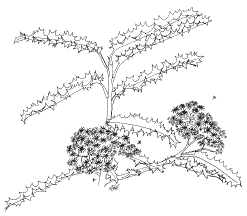 |
| Olearia ilicifolia. Illustration: Eleanor Burton. |
Huatoki Scenic Reserve & Tupari Reserve – map BH29
Two locals, Bill Clarkson and Cliff Lawrence, led us on tracks through some remarkable plant communities, including numerous, presumably pre-European, trees. They told us that 8.9% of New Plymouth’s land area is covered by indigenous plant communities, compared with an average of 1.9% for other New Zealand cities.
The city council, regional council and volunteer groups do pest plant and pest animal control in the extensive network of reserves in the gullies that run through the city. Bill has been working with pupils from Vogeltown School to propagate swamp maire and titoki, from seeds collected in these reserves, then planting the seedlings into them.
We were impressed to see
Collospermum hastatum and
Astelia solandri epiphytic on a big titoki, the orchid,
Icthyostomum pygmaeum, on hinau, and masses of the highly palatable
Brachyglottis kirkii / Kirk’s tree daisy. Later, kiekie, and big tawa, rewarewa, kahikatea, kohekohe, pukatea, and a 180-cm diameter rimu, plus having our lunch break in a community orchard with almost - ripe plums available, served to give us a “far-from-the-city” feeling. Among the species we added to the plant list were mangeao /
Litsea calicaris,
Drymoanthus adversus, and
Mida salicifolia.
Chris Horne
Ratapihipihi Scenic Reserve – map BH29
This reserve is southwest of central New Plymouth, off Cowling Rd and Tukapa St. Along the track through the lush, temperate rainforest, we saw nikau, large kohekohe and pukatea, and the dominant canopy species, multi-trunked tawa with elbows. We also saw saw-pits, dug when trees were felled here in the 1800s to build a schooner and bridges.
Chris Horne
Day 4, 23/1/12: North Egmont – map BJ29
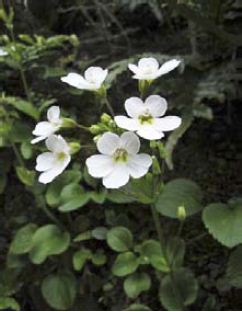 |
| Ourisia macrophylla. Photo: Val Smith. |
Fifteen of us met at North Egmont / Taranaki visitor centre to study the vegetation around the 1,000-m level on the Ngatoro and Veronica loop tracks, and the short Nature Walk. The 5-km drive through the lower altitude forest from the national park boundary had already indicated a good flowering year for the forest cabbage tree /
Cordyline banksii, and splashes of bright yellow from the herb,
Senecio rufiglandulosus, stood out from the sombre greens of the bush edge. (A difficult name to remember, and more difficult to say, until it is broken down to its Latin derivation:
rufus, fox-red;
glans, glands – “with small red glands”).
Our initial dismay at the rabbit population, weeds and poor condition of plantings, following earthworks for the recently revamped road-end facilities, was offset by the prolific flowering of established
Olearia ilicifolia, after which Holly Hut near Ahukawakawa Swamp is named, and robust Hebe sp. unnamed (H. “egmontiana”) still in bud. We entered gnarled, multi-trunked, kamahi “goblin forest” draped with the moss,
Weymouthia mollis, and an abundance of other mosses, liverworts and filmy ferns. The lush understorey of smaller trees and several fern species, including the attractive Prince of Wales feather,
Leptopteris superba, reflects the stringent goat control undertaken in the park. Although peak flowering of many species was over, the top whorls of flowers on large-leaved
Ourisia macrophylla were still evident in cool, damp areas at track and stream sides.
Terrestrial orchid species included the odd-leaved orchid
Aporostylis bifolia,
Simpliglottis cornuta / bird orchid, the spider orchid,
Singularybas oblongus, with its tubular dark maroon-fringed flower, and four greenhood species,
Pterostylis venosa,
P. humilis,
P. patens and
P. irsoniana. The latter, discovered in 1947 on Mt Taranaki by Owen Gibson and Bruce Irwin, was named after them by Dan Hatch using a combination of their two names. Sadly, Bruce, a highly regarded orchidologist and botanical artist, and the last of the trio, died this year at the age of 90.
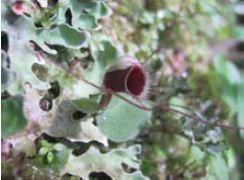 |
| Singularybas oblongus. Photo: Sam Buckley. |
We climbed only about 150 m, but the vegetation changed considerably, with distinctive golden-brown columnar trunks of pahautea /
Libocedrus bidwillii, and mountain totara /
Podocarpus cunninghamii, becoming dominant, and then giving way to leatherwood /
Brachyglottis elaeagnifolia scrub and red tussock /
Chionochloa rubra, as we emerged to enjoy the expansive views from Razorback. At the track edges,
Viola cunninghamiii,
Oxalis magellanica,
Myosotis forsteri,
Lobelia angulata and
Carmichaelia australis (with botanical names all incorporating those of people) were in flower. Additions to the plant list included
Fuchsia excorticata on the Ngatoro Loop, and on the Veronica Loop
Rubus cissoides,
Viola filicaulis,
Oreobolus sp.,
Poa anceps,
P. cita,
Rytidosperma gracile,
Uncinia ferruginea,
Cardiomanes reniforme and
Hymenophyllum villosum.
Val Smith.
Pouakai Range and Ahukawakawa Swamp – maps BH29 & BJ29
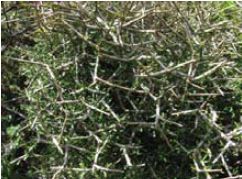 |
| Melicytus drucei. Photo: Barbara Hammonds. |
This was to be a big day. Up Mangorei Track to Pouakai (1200 m a.s.l.), over to the swamp (900 m a.s.l.) and return. The climb to Pouakai Hut was slow as we recorded species along the way; especially in the subalpine scrub zones with
Brachyglottis elaeagnifolia, and the track filled with
Celmisia glandulosa var.
glandulosa and
Abrotanella linearis. The layered shrubs of
Coprosma tayloriae were common. Fine weather gave us a magnificent view of inland North Taranaki. After lunch, we left for Ahukawakawa Swamp. Here
Carex coriacea and
Chionochloa rubra var.
inermis emerged from the mosses as we walked to the stand of
Melicytus drucei, interlaced with
Olearia quinquavulnera. Some of the plants were enclosed in cages, and many more were outside this, growing vigorously alongside other shrubs in an amazing, almost impenetrable, divaricating-shrub ‘jungle’, above which we could barely poke our heads. Other shrubs in this jungle were
Coprosma decurva,
C. tayloriae,
Hebe stricta var.
egmontiana and the small-leaved
Olearia quinquevulnera, in flower. It was necessary to crawl underneath the entanglement to see a new world of plants, including
Senecio rufiglandulosus, and other herb species. It was a relief to drop down below the canopy and on hands and knees investigate the treasures that were growing in the lush ecosystem at ground level, e.g.,
Myosotis forsteri,
Mentha cunninghamii and
Gonocarpus montanus.
It was well worth the effort to visit one of the most pristine swamps we have seen. Small infestations of yellow sedge,
Carex demissa, have begun to invade some areas.
Mick Parsons and Barbara Hammonds
Mangorei Track and Pouakai Range
The bush was delightful. We discussed the distinctions between
Coprosma tayloriae and
C. dumosa, and the variations in form of
C. tayloriae bearing in mind the recent work of David Glenny that argues that
C. tayloriae is a synonym of
C. dumosa. The leaf of
C. tayloriae is obovate and the mid-vein in at least some leaves doesn’t reach the leaf tip, whereas in
C. dumosa the vein always reaches the tip.
We saw
Blechnum nigrum, and learnt to identify
B. novae-zelandiae,
B. procerum and
B. montanum. Before sidling Photographer’s Peak, the canopy is about head height. The trackside vegetation included the small, strap-leaf plant,
Abrotanella linearis, a daisy, unusual because of its size, and its composite flower comprises only a few individual florets, and
Gentianella grisebachii, with its single flower heads on long, slender stems. Other plants included
Cyathea colensoi, growing close to the similar
C. smithii, and, on a
Libocedrus bidwillii, a patch of the blue-grey fronds of
Hymenophyllum malingii. The wind-shaped, moss-covered forms of the
Libocedrus itself were a sight to behold. It seems that
L. bidwillii is becoming the dominant canopy species. The delicate
Pterostylis graminea was flowering in the forest, and
P. patens on the more open trackside. Near the hut were tiny blue-green cushions of
Agrostis muscosa, and
Bulbinella hookerii growing in the
Chionocloa rubra tussock fields was in flower.
After lunch, some people went east towards Henry Peak to see the endemic
Melicytus drucei, some intensively botanising the plateau and surrounds. Most genera here were represented by only one or two species, e.g. only one
Ranunculus, and two
Celmisias, which is likely to reflect the history of active volcanism wiping out other species which were then unable to recolonise because the closest seed sources were too distant.
Highlights of the day included finding
Ranunculus nivicola on the tops, past flowering but still with seed heads, though many had been nipped off, likely by rabbits as their droppings and digging were obvious. Seeing alpine plants that we had previously seen only in books was a treat.
Barbara Hammonds
Day 5, 24/1/12: Manganui Ski-field, Mt. Taranaki – map BJ29
The walk from the cable-way, along the foot of bluffs in the Manganui River gorge, and up to the ski-field huts, had the usual range of low alpines. Near the tunnel, a major interest was in the coriarias – including
C. pteridoides and
C. sarmentosa, and the bigger plants had some people thinking they were
C. arborea. On the bluffs, the
Wahlengergia was new to us –
W. pygmaea var.
pygmaea – determined by the small rosettes, short stems and geographical distribution. The local
Hebe stricta var.
egmontiana was also present.
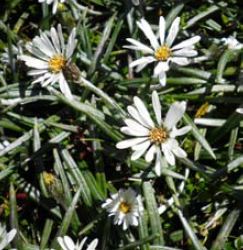 |
| Celmisia gracilenta. Photo: Gael Donaghy. |
We spread out over the ski-field for lunch and watched the more adventurous on the screes above. At the bottom of the run, the introduced
Carex ovalis dominated the wetter parts, with some
Gentianella grisebachii in flower. Many introduced grasses grow on the drier slopes –
Festuca rubra,
Holcus lanatus, and
Anthoxanthum odoratum. The highlight was some unusual patches of
Celmisia gracilenta – almost mats of them – in flower.
Two of us botanised a large gully beside the ski-field, and found more plants to add to the rather short list: an uncommon alpine grass,
Deschampsia tenella,
Trisetum lepidum agg.,
Polystichum cystostegia, the summer-green alpine fern of rocky places,
Cystopteris tasmanica, the delicate fern of caves and crevices, and
Schizeilema colensoi in delicate flower.
Gael Donaghy and Graeme Jane
The 40-minute walk from the Plateau car park to the ski-field took over 3 hours for most of us. Some climbed to the upper slopes, an unstable area being held together by the matted roots of
Coprosma perpusilla subsp.
perpusilla, their male flowers with large stamens poking up through the mossy surface. Hare damage was apparent even up there.
Euphrasia cuneata,
Forstera tenella, and
Montia calycina were in flower, but
Ranunculus nivicola had finished flowering.
Back down on the damp mown area, there were patches of
Juncus novae-zelandiae interspersed with the finer-leaved
Juncus pusillus. Elsewhere
Kelleria dieffenbachii and
Gunnera monoica were scattered across the area, along with the occasional
Microtis parviflora and mounds of
Oreobolus pectinatus.
Mick Parsons
Potaema Swamp
Features of the walk included huge rimu and kamahi,
Astelia grandis,
Gahnia xanthocarpa, swamp maire, and the fern,
Hypolepis rufobarbata. The view across the wetland to mighty Taranaki maunga ended a wonderful day out.
Chris Horne
Day 6, 25/1/12 Coastal herbfields – map BJ28
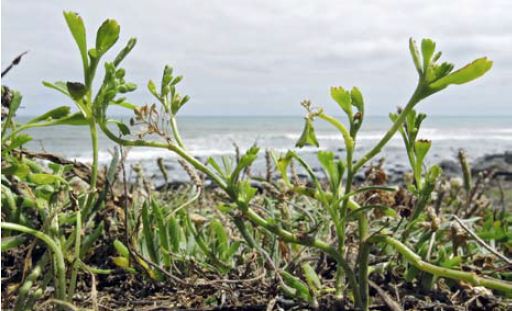 |
| Lepidium flexicaule. Photo: Sunita Singh. |
Though the herbfield remnants are tiny, we could not fit more than three sites in the day, and much of what we hoped to find is uncommon on the coast as a whole. We started at the end of Puketapu Road. Though still partly used as a metal quarry, there are small areas of undisturbed turf, but most of the cliff top areas are overrun with exotic grasses. There were scattered clumps of
Pimelea carnosa, and mats of
Agrostis mucosa. Fishermen had constructed a pathway down to a sea-level cave, now complete with boat and gear. The ledges were refuges for
Coprosma acerosa, with
Ficinia nodosa,
Apium prostratum,
Tetragonia implexicoma and
Samolus repens. Further down, tucked under
Phormium tenax, was
Asplenium appendiculatum subsp.
maritimum.
Opunake sewage ponds were a ‘pleasant’ spot to have lunch sitting, on Kikuyu grass,
Pennesitum clandestinum, that has all but overgrown the area’s herbfields.
Leptinella squalida was trying to repel the invasion. We saw the perennial
Myosotis pigmea among
Zoysia minima and scattered
Colobanthus muelleri.
Disphyma australis thrives along the cliff edge.
The highlight of the day was at Stent Road, Warea. Here by the car park was
Plantago triandra subsp.
masonii, and
Crassula manaia,
Chaerophyllum novae-zelandiae,
Colobanthus muelleri,
Ranunculus acaulis and
Zoysia minima. Much of the fenced-off area was overrun with white clover,
Trifolium repens, but
Lepidium flexicaule, in flower, was thriving among it. There were both forms of the annual,
Myosotis brevis, some in flower, on a small area of turf, and a few plants of a dichondra, probably
Dichondra brevifolia.
Burmeister property
There were noises from some members about the need to see some bush in this sparsely forested landscape, so we arranged to visit an isolated 2-ha block of coastal forest that the Burmeister family had saved. After negotiating electric fences, cow races with hedgerows of weedy species, and the remnants of a shed recently blown into the bush by a tornado, we were pleased by what we found. Beneath a battered canopy of kohekohe and titoki, the forest was almost impassable for the healthy lianes within. Vines of
Freycinetia banksii,
Passiflora tetrandra,
Muehlenbeckia australis and
Ripogonum scandens filled every possible gap. The ground was covered in seedlings of
Rhopalostylis sapida,
Knightia excelsa and
Laurelia novae-zelandiae, as well as a number of fern species, e.g.
Asplenium bulbiferum,
A. oblongifolium,
A. polyodon and
Deparia petersenii subsp.
congrua. The larger trees, their tops exposed by wind damage, were covered in epiphytes such as
Collospermum microspermum,
Earina mucronata and
E. autumnalis. Its isolation meant that the bush edge was vulnerable to invasion from weeds. The threat of Japanese honeysuckle,
Lonicera japonica, overgrowing the entire bush from the western side is real and would have to be dealt with if this block is to be saved long-term.
Mick Parsons
Talk by Bill Clarkson
Bill described to us the work he had done with local schools in propagating threatened plants, and his observations on the younger generation’s involvement in some of the environmental awareness programmes he participated in. He completed the evening with a passionate call to save swamp maire. It was easy to see how its plight reflected the nature of land use in Taranaki, and the continued drainage of soaks. Despite there being a stream riparian management plan for every farm in Taranaki, nothing was being done to care for streams in their upper catchments, and the many drained soaks that exist on most farms. Swamp maire (waiwaka) is now rare, and more were being removed on farms.
Mick Parsons
Day 7, 26/1/12: Toro Road – map BH30
We botanised this 260-ha QEII covenant owned by David and Marie Russell at Purangi. The property, once farmed by Tom Watt, an Acclimatisation Society enthusiast, was gifted to the society, which later offered it for sale. The Russells, concerned to see its heritage honoured, bought the property. We were greeted by Dean Caskey, Taranaki Regional Council Biodiversity Officer, who outlined the farm’s history, and explained the pest control status. While one group worked their way up the valley, the rest followed Dean around the ridge tops as he checked the trap lines. Before we had even entered the forest proper, we had added to the plant list several species found in cut-over inland Taranaki forest. Besides some grand northern rata,
Metrosiderous robusta, there were
M. diffusa,
M. perforata,
M. fulgens and
M. colensoi. The three maire,
Nestegis cunninghamii,
N. lanceolata and
N. montana, and two totara;
Podocarpus totara and
P. cunninghamii were found, as were the epiphytic orchids
Earina mucronata,
E. autumnalis and
Winika cunninghamii.
Two of us followed a line to the bottom of a gully with a small swamp where we added the ferns
Hymenophyllum flabellatum,
H. franklinii and
H. revolutum. In the swamp area we added several sedge species, including
Uncinia forsteri and
Carex maorica, before we returned through a stand of
Quintinia serrata and
Laurelia novae-zelandiae, under which there were shrubs of kaikaiatua /
Rhabothamnus solandri. Lunch was perfumed by the smell of possum carcasses from nearby trap stations, but the reward was finding
Botrychium biforme where we sat, and soon we saw Pittosporum cornifolium on a large rata. The cliffs below us were edged with Dracophyllum strictum, and when we emerged into light areas, the track cuttings were covered in
Drosera binata.
Mick Parsons
A small group botanised the swamp area, then walked up a farm road leading to the ridge on the east side of the valley. The high banks cut into the hillside provide habitat for many plants, most notably young
Dracophyllum strictum, long trails of
Lycopodium scariosum, and some
Nematoceras oblongus. Near the top of the ridge, a
Metrosideros perforata, resplendent with white flowers, covered an area of at least 2 m
2.
Sunita Singh
A group of two walked up a gully below the farm road mentioned above. Under the tawa canopy, they noted
Blechnum colensoi, usually found in wet sites, growing on a well-drained spur, saw severe browse on kiekie, and heard a North Island robin.
Chris Horne & Gavin Dench
Day 8, 27/1/12: Kereru Keep, Tikorangi Rd East – map BH30
Janica Amor provided her plant list, and led us on this trip on Neil and Jackie Whitehead’s farm. The sight of a sprinkler expelling effluent onto a paddock as we arrived was a fitting symbol of the casting out of previous impressions some of the group may have had of how dairy farmers manage native vegetation on their land. Sheltered from a shower in an implement shed, Jackie explained how she engendered community support to assist with the management of their three QEII bush covenants, each of 3 ha, on their 120 ha dairy farm. The fact that kiwi had been heard within the vicinity stimulated friends and neighbours, as well as the business community, e.g. Methanex, to help when Jackie sought help. Taranaki Regional Council helped them to acquire the technical expertise and poison licence for a self-help pest control programme, some neighbours adopted a trap or bait station, while others assisted with making tracks and bridges to provide access. Jackie set up a web site to keep everyone up-to-date with general news and pest-control successes. The result is that the Tikorangi community ‘owns’ and takes deserved credit for the successful regeneration of this bush. The model is one that deserves to be emulated elsewhere. It was still raining as we walked to the first block. Inside the gate, the damage cattle can do was apparent. Two nikau,
Rhopalostylis sapida, showed evidence of browsing, yet Neil said it had been four years since a lone cow broke into the reserve. The first block had a track along a ridge among a canopy of large tawa, kohekohe and pukatea. A few kahikatea and miro emerged above. We descended a track lined with king fern, and then down and across a swamp area festooned with banks of brown-leaved parataniwha,
Elatostema rugosa. As we emerged from the bush over a stile beneath a kahikatea smothered in seed, we saw a lone swamp maire,
Syzygium maire, in a side stream and soak that ran into the bush covenant from which we had emerged. It highlighted the plight of this species emphasised to us by Bill Clarkson. Despite efforts by farmers to save bush habitats, this species occupies habitats at the top of catchments too easily removed in the past, and difficult to reconstruct.
The second bush covenant, c. 100 m away, on a higher well-drained site, featured a large rimu and a viewing platform. We saw extensive beds of parataniwha and numerous king fern / para /
Ptisana salicina. We emerged at the top of this bush to open farmland and sunshine, and returned to the homestead, for a late lunch in the sun.
Mick Parsons
Participants : Beth Andrews, Rita Chin, Barbara Clark, Rae Collins, Gavin Dench, Jenny Dolton, Gael Donaghy*, Rewi Elliot, Dale Every, Julia & Ken Fraser, Bryan & Robyn Halliday, Barbara Hammonds, Margaret & Richard Herbert, Chris Hopkins, Chris Horne, Hilarie Hoskin, Priscilla Isaacs, Graeme Jane*, Brenda Johnston, Rodney Lewington, Finn Michalak, Barbara Mitcalfe, Syd Moore, Mick Parsons (trip organiser / leader), Emil Schmieg, Darea Sherratt, Sunita Singh, Val Smith, Laurel Stowell, Yvonne Weeber.
* = provider of plant lists
We thank the following local people who guided us on day trips: Janica Amor, Dean Caskey, Bill Clarkson, Barry Hartley, Cliff Lawrence, Kara Prankerd, and members of the Whanganui Museum Botanical Group.

 Site Index
Site Index







 Site Index
Site Index





